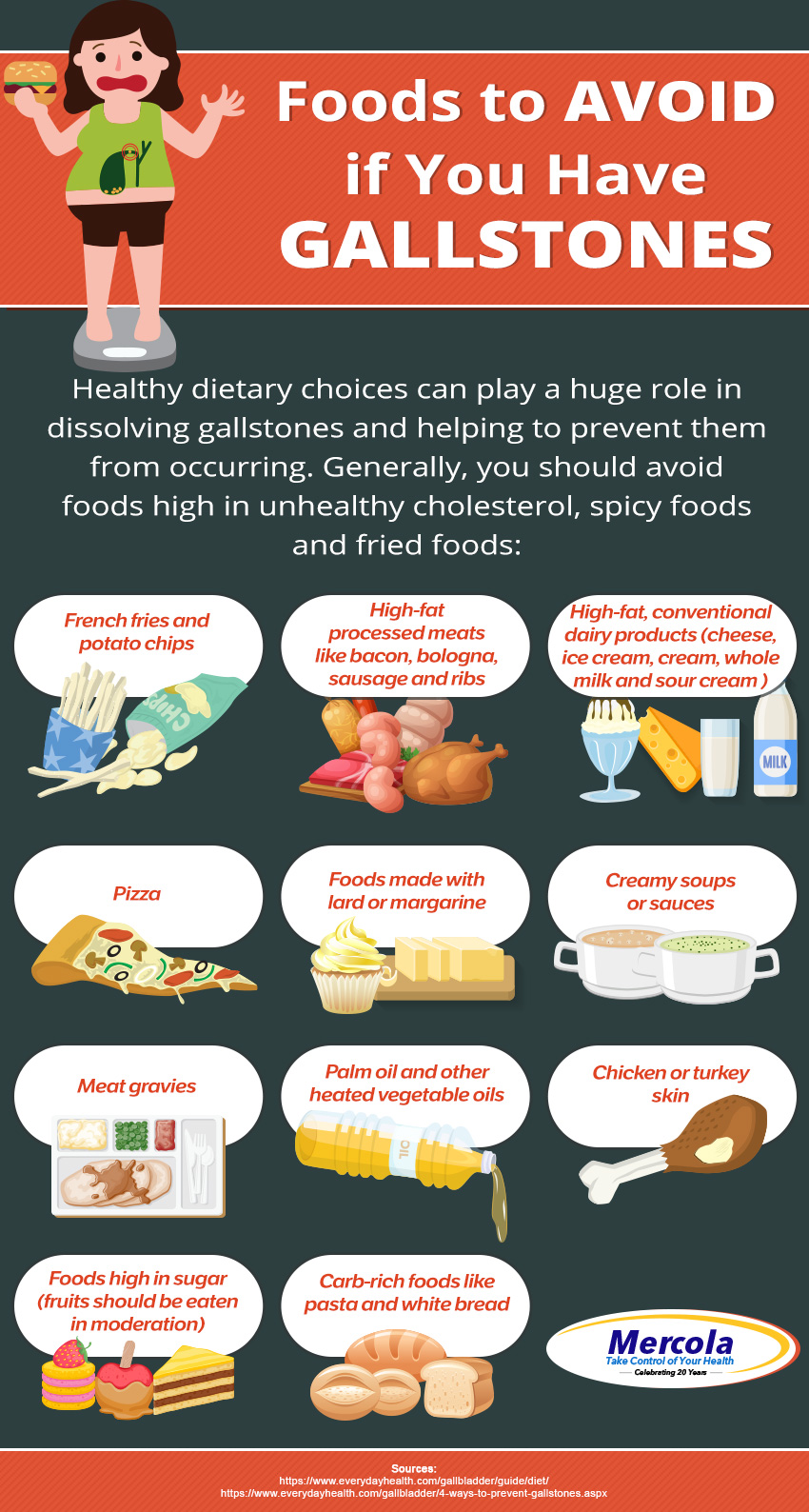Dr. Mercola on Gallstones
Gallstones: What Are Its Causes and Symptoms?
- 19,637 views

Story at-a-glance
- According to the Mayo Clinic, gallstones, or chlolelithiasis, are hardened deposits of digestive fluid that form in your gallbladder
- An imbalance in the chemical composition of bile is said to be predominantly responsible for gallstones
- In the U.S., around 12 percent of the population — or roughly 36 million people — are affected with gallstones
- Although no definite preventive techniques for gallstone development has been discovered yet, research shows that there are ways to lower the risk for these stones
- Generally, you should avoid gallstone-causing foods, such as those high in unhealthy cholesterol, spicy foods and fried foods
Found under the liver and on the upper right side of the abdomen, the gallbladder is a pear-shaped organ that stores bile, a digestive enzyme that’s produced by the liver and is passed along to the small intestine. Bile is important for the body as it helps digest fats in the small intestine.1, 2 But, just like other organs, the gallbladder is also prone to diseases, with gallstones being a major example.
What Are Gallstones?
According to the Mayo Clinic, gallstones, or chlolelithiasis,3 are hardened deposits of digestive fluid that form in your gallbladder. Gallstones are usually made of bile, which is composed of water, cholesterol, fat protein, bilirubin and bile salts. This liquid is produced by the liver to help with digestion and is stored in the gallbladder until the body needs it.
Gallstone sizes vary, with some as small as a grain of sand, and others as large as a golf ball. Oftentimes, some people develop a single gallstone, although some have multiple gallstones at the same time.4
What Are the Types of Gallstones That Can Form in the Body?
There are two types of gallstones that can form in your gallbladder. These are:5, 6
•Cholesterol gallstones: These stones are usually yellow, and are the most common type, responsible for around 80 percent of gallstones among individuals in Europe and the Americas. Although they are mainly composed of undissolved cholesterol, these stones may also contain other components.
•Pigment gallstones: These dark brown or black stones often develop if you have too much bilirubin in your bile. However, pigment gallstones may also consist of phosphate, carbonate and other anions.7 Pigment gallstones comprise only 15 percent of stones among people from Europe and the Americas, although these stones are more common among Southeast Asians.
What Causes Gallstones?
What ultimately causes gallstone formation is still unclear. However, researchers have discovered instances that might prompt gallstone development. In particular, an imbalance in the chemical composition of bile is said to be predominantly responsible for gallstones, especially when:8
•Bile contains too much cholesterol: Dissolving cholesterol released by the liver requires certain chemicals, and usually, bile contains sufficient amounts of them to dissolve the cholesterol. But if there is more cholesterol excreted and there isn’t enough bile to dissolve it, the excess cholesterol can develop into gallstone crystals.
•Bile contains too much bilirubin: A chemical produced when the body breaks down red blood cells, bilirubin levels can significantly increase among people with liver cirrhosis (scarring of the liver), biliary tract infections or certain blood-related conditions. Gallstones may eventually form if there’s too much bilirubin in your system.
Aside from these two bile-related causes, people whose gallbladders don’t empty correctly may experience gallstones. This is because a failure of the gallbladder to empty completely or often enough can cause bile to become very concentrated and lead to gallstone formation.9
Risk Factors for Gallstones
There are factors that can increase a patient’s risk for gallstones. These include:10, 11
| Gender (females are more prone to have gallstones12) | Age (particularly being 40 years old or above) |
| Race (Native Americans or Mexican-Americans) | Being overweight or obese |
| Being sedentary | Being pregnant |
| Eating a high-fat or high-cholesterol diet | Eating a low-fiber diet |
| Losing weight very quickly | Having diabetes |
| Having a family history of gallstones | Having a disease that affects the flow of bile, such as cirrhosis, primary sclerosing cholangitis or obstetric cholestasis |
| Having Crohn’s disease or irritable bowel syndrome (IBS) | Taking estrogen-containing medicines like oral contraceptives or hormone therapy drugs |
| Taking an antibiotic called ceftriaxone |
How Prevalent Are Gallstones?
Women, older people and overweight people are more prone to developing gallstones.13 The highest rates of gallstones occur in the U.S., Chile, Sweden, Germany and Austria.
In the U.S., around 12 percent of the population — or roughly 36 million people — are affected with gallstones. According to Ferri’s Clinical Advisor 2017, 2 to 3 percent of this number, or about 500,000 to 600,000, have surgeries on average each year to remove their gallbladder. This makes gallstones the most common gastrointestinal disorder that requires hospitalization.14
Having gallstones isn’t cheap, either. In the U.S., gallstones cost Americans over $5 billion a year and possibly more.15 This makes it the second most expensive digestive disease in the U.S., only surpassed by gastroesophageal reflux disease.16
Can You Get Gallstones While Pregnant?
Yes. In fact, the risk of gallstones may increase during pregnancy. This is because during pregnancy, the body increases its production of estrogen to support the growing baby’s needs. Increased estrogen levels may prompt cholesterol levels in bile to increase and lead to gallstone formation.
In some cases, gallstones do not trigger problems or symptoms and may resolve on their own after the baby’s delivery. However, pregnant women who experience any of the symptoms below must consult their OB/GYN or physician immediately:
| Steady and increasing pain in the upper right part of the abdomen, especially after eating a fatty meal | Pain between the shoulder blades or under the right shoulder |
| Abdominal pain that lasts more than five hours | Nausea and vomiting |
| Fever or chills | Jaundice or yellowing skin |
| Clay-colored stools |
An abdominal ultrasound can determine the presence of gallstones. Prior to undergoing any examination for gallstones, remind your doctor or physician about your pregnancy. Certain gallstone diagnostic tests, such as an oral cholecystogram (X-ray of the gallbladder), computed tomography (CT) scan or nuclear scan, aren’t safe for pregnant women.17
How Do Gallstones Affect Your Body?
If left untreated, gallstones may lead to unwanted complications such as:18
•Gallbladder inflammation: If a gallstone becomes lodged in the neck of the gallbladder, it can prompt gallbladder inflammation or cholecystitis, and trigger severe pain and fever.
•Bile duct blockage: Multiple gallstones can block tubes or ducts that facilitate passage of bile from your gallbladder or liver to your small intestine. Once this happens, it can lead to an infection of the bile duct, as well as jaundice.
•Pancreatic duct blockage, and consequently, gallstone pancreatitis: This tube runs from the pancreas to the common bile duct, and serves as a passageway for pancreatic juices that aid in digestion. If a gallstone blocks this pathway, it can prompt gallstone pancreatitis (inflammation of the pancreas).19 People with gallstone pancreatitis experience intense and constant abdominal pain, and may require hospitalization.
•Gallbladder cancer: It’s said that people with a history of gallstones may have a higher risk for gallbladder cancer. However, this type of cancer is very rare, so even if there’s an elevated cancer risk, the likelihood of this disease affecting a person may be very small.
Gallstones Versus Kidney Stones

Although they both occur in the lower part of the body, there are key differences between gallstones and kidney stones:20
| Gallstones | Kidney Stones |
|---|---|
|
|
Signs and Symptoms of Gallstones You Should Not Miss
Generally, gallstones do not prompt symptoms. However, if one becomes lodged in a duct and causes blockage, the following signs may appear:21
- Abrupt and quickly intensifying pain in the upper right part of the abdomen, and/or in the center of your abdomen, just below the breastbone
- Back pain between the shoulder blades
- Pain in the right shoulder
- Nausea or vomiting
The pain may last for several minutes up to a few hours. You should consult a physician immediately if you notice any of the aforementioned symptoms, but most especially if these conditions appear:
- A high fever with chills
- Yellowing of the skin and the whites of the eyes
- Intense abdominal pain that prevents the patient from sitting still or finding a comfortable position
Conditions such as appendicitis, ulcers, pancreatitis and gastroesophageal reflux disease may yield indicators that are similar to gallstones. In certain cases, “silent gallstones” may be discovered even if a patient does not have indicators. Case in point: A health care provider may notice gallstones while performing an ultrasound for another reason.
How to Diagnose Gallstones
A physician can employ any of these methods to check for gallstones, as highlighted by the University of California San Francisco:22
•Ultrasound: A device called a transducer bounces safe and painless sound waves off organs to develop an image of their structure. An ultrasound can be done by a specially trained technician, either in a health care provider’s office, outpatient center or hospital.
A radiologist (a doctor specializing in medical imaging) inspects these results. Ultrasounds are highly accurate in detecting gallstones because the stones are very visible in the image.
•Computerized tomography (CT) scan: This type of procedure produces three-dimensional images using X-rays and an injection of a special dye called the contrast medium.
Just like with an ultrasound, anesthesia isn’t needed. Results of a CT scan may display gallstones, and/or complications like an infection and blockage of the gallbladder or bile ducts. Unfortunately, there are instances wherein CT scans might miss undetected gallstones in your body.
•Magnetic resonance imaging (MRI): MRIs can show gallstones lodged in the ducts of the biliary system. Detailed pictures of the body’s internal organs and soft tissues are produced by MRI machines that utilize radio waves and magnets. While MRIs don’t require anesthesia, a person with a fear of confined spaces may be lightly sedated.
•Cholescintigraphy: Also called a hydroxyl iminodiacetic acid scan, HIDA scan or hepatobiliary scan, cholescintigraphy is a test that aims to deliver pictures of the biliary system. This procedure doesn’t require anesthesia, and is often used for identifying abnormal contractions of the gallbladder or obstruction of the bile ducts.
A small amount of radioactive but harmless dye is administered into a vein in the patient’s arm. Once done, a special camera takes pictures of the radioactive material as it moves through the biliary system.
•Endoscopic retrograde cholangiopancreatography (ERCP): In this method, an X-ray is used to inspect the bile and pancreatic ducts. Prior to an ERCP, a patient is lightly sedated.
An endoscope, a small and flexible tube fixed with a light and a camera at the end, is inserted through the mouth, and into the duodenum and bile ducts. A contrast medium is then injected via a tube into the patient’s bile ducts, so these organs can be visible to a computer and a monitor attached to the endoscope.
This test detects the affected bile duct and identifies where the gallstone is. The stone may then be removed and captured onto a tiny basket attached to the endoscope. Take note, however, that an ERCP tends to be more invasive compared to other tests, and is only used selectively.
Apart from the aforementioned diagnostic tests, your physician may also recommend a blood test to search for signs of infection or inflammation of the bile ducts, gallbladder, pancreas or liver.23
How to Treat Gallstones Effectively
Gallstones that don’t cause symptoms usually do not need medical treatment. If unpleasant symptoms manifest, however, medical attention is necessary. Depending on the size and location of the stone, conventional treatment protocols may include:24
•Lithotripsy: This is a special machine that aims to shatter gallstones by producing soundwaves. However, a lithotripsy is only recommended for people with small and soft stones and is only utilized in certain centers.
•Medications: Take note, however, that medicines to dissolve gallstones are rarely given because of a variable success rate — sometimes the stones will recur or the medication won’t work at all — and the risk of certain side effects, such as dermatological problems and a general feeling of illness.
The symptoms and results of diagnostic testing will serve as your physician’s basis in determining the ideal treatment method for gallstones. Treatment/s can be suggested if gallstone symptoms occur in the future.25
The U.K.’s NHS further notes that physicians may recommend gallstone treatment if a patient has a condition that predisposes them more to diseases such as diabetes, cirrhosis or portal hypertension (high blood pressure inside the liver that is usually a complication of alcohol-related liver disease).
If no gallstone symptoms appear, “active monitoring” may be recommended. What this means is that you won’t receive immediate treatment, although you should let your doctor know if you experience pain or other symptoms. The rule of thumb is, the longer you go without symptoms, the lower the possibility of your condition getting worse.26
How to Get Rid of Gallstones Naturally
Before considering conventional treatment options, you may want to check out these natural remedies for gallstones first. They’re relatively inexpensive, safe and potentially effective:27
•Apple cider vinegar (ACV): The vinegar’s acidic nature may prompt the liver to produce less cholesterol.28, 29 According to the book “Water, The Shocking Truth,” substances like malic acid, potassium, pectin and enzymes, all of which may be found in apple juice and can be transferred to apple cider vinegar, are also known to play a role in alleviating pain and dissolving gallstones.30
•Lemon juice: In general, lemons may inhibit the body from becoming too acidic and turn into a breeding ground for gallstones. Plus, large amounts of limonene, a component found in lemons, may assist in dissolving cholesterol, making it potentially helpful in keeping gallstone attacks at bay. Another component called pectin in lemon juice is believed to aid in making sure bile acids stay in the gut so they won’t develop into gallstones.31
•Organic psyllium husk:32 This can serve as a gallstone treatment since fiber in psyllium is known to bind to the cholesterol in bile and assist in preventing gallstone formation.33 Just make sure to use organic and 100 percent pure psyllium husk, as it is a heavily sprayed crop, with many sources often being contaminated with harmful pesticides.
•Milk thistle: A substance called silymarin34 in milk thistle can stimulate bile production, which may resist its solubility and eventually assist with flushing out gallstones.35
•Pears: Pectin is also present in pears, and it assists with softening gallstones and allows them to be flushed out easily.36
Be Cautious When Using These Common Treatment Protocols for Passing Gallstones
If none of the home remedies mentioned above work, you can consult your physician on conventional treatment methods that may help ease your condition. However, be aware that these can have drawbacks for your health:37
•Oral bile acids: Certain chemicals or substances like ursodiol or chenodiol are available as oral bile acid pills that may have the ability to dissolve stones. These oral bile acids initiate stone dissolving by thinning the bile.
Not everyone can take oral bile acids for gallstones, even if they may seem effective and generally well-tolerated. Oral bile acids are only ideal for patients with small and cholesterol-based gallstones. Plus, major side effects were linked to two types of oral bile acids in ursodiol (sold under brand names Actigall and Urso) and chenodiol:38, 39
| Ursodiol | Chenodiol |
|---|---|
|
|
•Contact dissolution therapy: In order to dissolve gallstones, methyl tertiary-butyl ether (MTBE), a type of solvent, is injected into the gallbladder. While initial studies have highlighted MTBE’s potential in rapidly dissolving stones, this procedure can also trigger severe side effects like a burning pain sensation. If you’re thinking about undergoing contact dissolution therapy, inquire about your doctor’s level of experience in performing this procedure. Better yet, look for safer alternatives for gallstone treatment.
•Extracorporeal shock wave lithotripsy (ESWL): An ESWL involves sending shock waves through the body’s soft tissues to shatter gallstones into smaller fragments. Unfortunately, only less than 15 percent of gallstone patients may find ESWL effective, since it only works on solitary gallstones that are less than 2 centimeters in diameter.
•Percutaneous cholecystostomy: In a percutaneous cholescystostomy, a needle is first inserted to extract fluid from the gallbladder. Afterward, a catheter is inserted through the skin to drain fluid. It’s left in place for a few weeks, after which surgery to remove the gallbladder is done to prevent recurrence. A percutaneous cholecystostomy is often given to severely ill patients who aren’t able to tolerate surgery right away.
It’s highly advisable to have a thorough discussion with a physician or health expert before opting for any of these conventional methods to treat gallstones, so you will know the protocol that is ideal for your condition and avoid complications.
What You Need to Know About Gallstone Surgery
If natural methods for gallstone removal aren’t working, your physician may advise that you undergo one of these three surgical procedures.
Laparoscopic Cholecystectomy
Also called keyhole surgery, a laparoscopic cholecystectomy involves the surgeon making three to four small cuts in the abdomen. The smaller cuts measure 1 centimeter or less each, and are located on the right side of the abdomen, while the large cut measures 2 to 3 centimeters and is located near the belly button.40
After making the cuts, carbon dioxide gas is temporarily inflated into the abdomen. This is harmless, and is done in order for the surgeon to easily view the organs. A long, thin telescope with a tiny light and a video camera at the end, called a laparoscope, is inserted through one of the cuts. A video monitor allows the surgeon to see the area/s that need to be operated.
Special surgical instruments are then used to remove the gallbladder. An x-ray or ultrasound scan of the bile duct can be taken during the operation if gallstones are present in the bile duct. In some cases, these stones may be removed by the surgeon on the spot.
Abdominal gas discharges via the laparoscope, and cuts are closed with dissolvable stitches and covered with dressings once the gallbladder is removed. A typical laparoscopic cholecystectomy is performed under a general anesthetic, enabling the patient to fall asleep before the procedure and not feel any pain.
This procedure can be done in 60 to 90 minutes, and full recovery can take up to 10 days. However, not everyone can undergo a laparoscopic cholecystectomy. The following groups of people are not recommended for this surgical procedure:
- Women in their third trimester of pregnancy
- People who are extremely overweight
- People who have an unusual gallbladder or bile duct structure that makes a keyhole procedure difficult and potentially dangerous
Single-Incision Laparoscopic Cholecystectomy
This is a newer type of keyhole surgery that may be used to remove the gallbladder and gallstones.41 It’s similar to the laparoscopic cholecystectomy mentioned earlier, although only one small cut is needed.
However, since a single-incision laparoscopic cholecystectomy is not performed often, some people may be skeptical about it. Furthermore, access to this surgery is limited because it needs to be performed by an experienced surgeon with specialist training.42
Open Cholecystectomy
People who aren’t recommended for a laparoscopic cholecystectomy may be advised to undergo an open cholecystectomy, wherein a surgeon may remove your gallbladder after making a 10- to 15-centimeter (or 4- to 6-inch) incision in the abdomen underneath the ribs.
An open cholecystectomy is also done under a general anesthetic, and this procedure is said to be just as effective as laparoscopic surgery. However, the recovery time for an open cholecystectomy is longer, and it causes visible scarring. Patients who undergo this procedure might have to stay in the hospital for up to five days, and full recovery may take six weeks.43
How to Prevent Gallstones Effectively
Although no definite preventive techniques for gallstone development has been discovered yet, research shows that there are ways to lower the risk for these stones.44 One is to refrain from taking medications that can increase your risk for gallstones. These include:45
•Cholesterol-lowering drugs: Medicines like gemfibrozil (Lopid) and fenofibrate (Tricor) can increase your gallstone risk. Although they may decrease blood cholesterol levels, these medicines can also raise the amount of cholesterol released in bile.
•Hormone therapy: HRT refers to the administration of estrogen or a combination of estrogen/progestin therapy.46 For women in particular, increased estrogen levels may lead to a higher gallstone risk.47 As such, if you are undergoing HRT or are taking high-dose birth control pills, talk to your doctor about your gallstone risk and ask if there are other hormone-related medications that are better for you.
A Healthy Lifestyle Can Lower Your Gallstone Risk
Decreasing your risk for gallstones begins with a healthy lifestyle, specifically by following these habits:48, 49
•Maintaining a healthy weight: People who are overweight or obese have a higher risk of gallstones. If you keep your weight at a healthy level, your risk for gallstones is reduced. Consistently watch what you eat and make sure you eat healthy foods regularly.
•Exercising regularly: Research shows that moderate physical activity can help increase the body’s levels of high-density lipoprotein cholesterol (HDL) or “good” cholesterol.50
Out of the many workouts available today, high-intensity interval training (HIIT), particularly the Peak Fitness method, is the best choice to help with this goal. During a HIIT workout, you train for a shorter period of time and reduce the frequency required to perform the exercise. In a HIIT workout, you perform short bursts of very short and high-intensity drills. In general, HIIT workouts can lead to:
| Decreased body fat | Improved muscle tone |
| Firmer skin and less wrinkles | Increased energy levels and libido |
| Enhanced athletic speed and performance | Ability to achieve fitness goals faster |
The Peak Fitness method can also engage the fast and super-fast twitch muscle fibers that have many beneficial effects on your body’s metabolic systems, especially when it comes to promoting the production of the human growth hormone (HGH) and potentially improving your longevity.
What’s the Ideal Diet for Gallstones?
Healthy dietary choices can play a huge role in dissolving gallstones and helping to prevent them from occurring. Generally, you should avoid gallstone-causing foods, such as those high in unhealthy cholesterol, spicy foods and fried foods. Here’s a list of what to avoid if you’re dealing with this health problem:51

| French fries and potato chips | High-fat processed meats like bacon, bologna, sausage and ribs |
| High-fat, conventional dairy products like cheese, ice cream, cream, whole milk and sour cream | Pizza |
| Foods made with lard or margarine | Creamy soups or sauces |
| Meat gravies | Palm oil and other heated vegetable oils |
| Chicken or turkey skin |
In addition, reduce the amount of sweets that you eat and make sure to eat fruits in moderation, since a high-sugar diet can lead to gallstones. Refrain from eating pasta, white bread and other carbohydrate-rich foods too. Because carbohydrates are eventually converted into sugar in the body, carb-rich foods can increase your gallstone risk.52
What Foods Should You Eat if You Have Gallstones?
High-fiber foods are an important component of a gallstone patient’s diet. Good choices include:
| Broccoli | Cauliflower | Leafy greens |
| Herbs | Celery | Carrots |
| Sweet potatoes | Artichokes | Onions |
| Asparagus | Zucchini | Apples |
| Bananas | Berries (remember to eat in moderation) | Cherries |
| Papaya | Pineapple | Oranges |
Don’t forget to incorporate the following foods into your diet too:
- Unlimited amounts of fresh, organic and low-net carb vegetables, especially fiber-rich options (just make sure to introduce these foods slowly into your diet, since they can prompt digestive discomfort, especially in those who have had gallbladder surgery)
- Moderate quantities of high-quality protein from organically raised, grass fed animals
- High portions of healthy fats
The only drawback of eating high-fiber and gas-producing foods if you have gallstones is that it may cause some digestive discomfort after undergoing gallbladder surgery. As such, it would be better to introduce them slowly into your diet.53
Just take note that beans and legumes contain lectins, which may be detrimental to your health when consumed in excess. For more information on how to prepare your beans and legumes properly and help mitigate the potential negative health risks linked to lectins, read this article.
Moreover, don’t forget to drink at least eight to 10 glasses of water per day.54 Not only will drinking water assist in keeping bile production running smoothly, but it can help flush cholesterol out of the body, too.55
Is Fat Bad for You if You Have Gallstones?
As mentioned earlier, high-fat foods are a no-no if you have gallstones. However, this piece of advice applies to certain types of harmful fat only. Not all types of fat are bad for you if you have gallstones, with the following types of fats possibly having the potential to reduce your gallstone risk:56
- Monounsaturated fats: Found in olive oil and canola oil
- Omega-3 fatty acids: Found in flaxseeds, avocados and coconut oil
Instead of switching to low-fat foods, consume fats in moderation. Avoid eating too much fat at one mealtime and try reducing your meal portions. These habits might help find specific foods that can trigger gallstone symptoms. Some of your best sources include fats from avocados, coconut oil, organic grass fed butter, pastured egg yolks, and raw nuts like macadamias, pecans and pine nuts.
Consider keeping a food and symptom diary to track foods responsible for indicators. If you notice a pattern, avoid symptom-triggering foods for a two-week trial period and take note of improvements to your symptoms.57
Other Dietary Reminders for People With Gallstones
If you’re looking to lose weight alongside reducing or preventing gallstones, follow a gradual weight loss plan. Do not attempt to do low-calorie and rapid weight loss diets, fasts or detoxes,58 as there is evidence that they can disrupt your bile chemistry and increase your chances for developing gallstones.59 Instead, if you are overweight, lose the excess weight slowly — at least 1 to 2 pounds, or 0.5 to 1 kilogram, per week.
Frequently Asked Questions About Gallstones
Q: How do you get gallstones and how do they form in your body?
A: A person can develop gallstones if there is an imbalance in the chemical composition of their bile. Stones can form if the bile contains excessively high levels of substances like cholesterol or bilirubin.60 In some cases, gallstones can develop if the patient’s gallbladder fails to empty completely or if it doesn’t empty often enough. This can cause the bile to become very concentrated and result in stone formation.61
Q: What do gallstones look like, and what are they made of?
A: Gallstones look like hardened deposits of digestive fluid that can be as small as a grain of sand or as big as a golf ball. A stone’s color depends on the substance it’s made of. Yellow stones are cholesterol gallstones that are made of the said substance, alongside other components in your bile.
On the other hand, dark brown or black stones are pigment gallstones that form because of having too much bilirubin in your bile.62These stones may also consist of calcium salts of phosphate, carbonate and other anions.63
Q: Are gallstones dangerous?
A: While gallstones do not generally trigger symptoms, these complications can occur if stones are left untreated:64
•Gallbladder inflammation
•Blockage of the common bile duct
•Gallstone pancreatitis (blockage of the pancreatic duct)
Gallbladder cancer is another reported complication of gallstones, although this is rare.
Q: Do gallstones hurt?
A: Yes. If a stone gets lodged in a duct and prompts a blockage, a patient can experience extreme pain and discomfort that may last for several minutes up to a few hours. Common gallstone symptoms include:65
•Sudden and rapid pain that intensifies in the upper right part of the abdomen, and/or in the center of your abdomen just below the breastbone
•Back pain between the shoulder blades
•Pain in the right shoulder
•Nausea or vomiting
If a patient notices any of the following indicators, he or she must seek medical attention immediately:
•A high fever with chills
•Yellowing of the skin and the whites of the eyes
•Intense abdominal pain that prevents the patient from sitting still or finding a comfortable position
Q: Are gallstones hereditary?
A: There may be a hereditary link to gallstones, since having a family history of gallstones can play a role in increasing a patient’s risk for this condition. However, there are other factors that can trigger the disease, such as gender, race, age, lifestyle habits and existing diseases that the patient may have.66
Q: How are gallstones diagnosed?
A: A physician will perform any of these five diagnostic methods to determine whether a patient has gallstones:67
•Ultrasound
•Computerized tomography (CT) scan
•Magnetic resonance imaging (MRI)
•Cholescintigraphy
•Endoscopic retrograde cholangiopancreatography (ERCP)
Aside from these procedures, a physician can also recommend tests to check for indicators of infection or inflammation in the bile ducts, gallbladder, pancreas or liver.
Q: Can you pass a gallstone?
A: Yes. According to Cedars-Sinai Medical Center, most gallstones tend to be small enough to pass out of the body via the intestines without you noticing.68
Q: How do you treat or dissolve gallstones?
A: Some gallstones may not require medical treatment because they don’t prompt symptoms. If treatment is needed to remove gallstones from the body, it may include the following:69
•Changes to the patient’s diet
•Lithotripsy
•Medications (although these are rarely given because they can lead to unpleasant side effects)
•Surgical procedures like laparoscopic cholecystectomy, single-incision laparoscopic cholecystectomy or open cholecystectomy70
Arguably, natural methods, as opposed to conventional treatment protocols, are better when it comes to dissolving these stones and flushing them out of your body.













